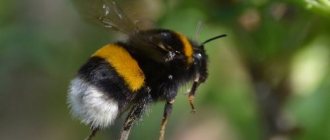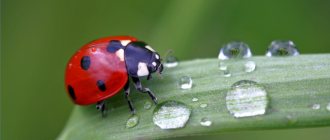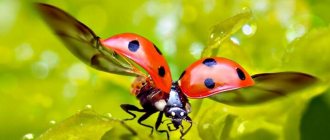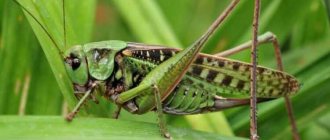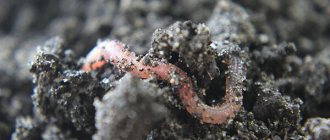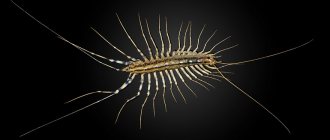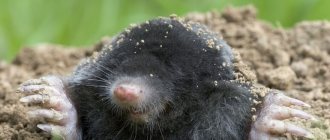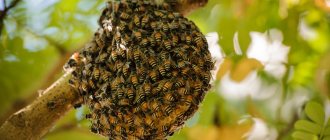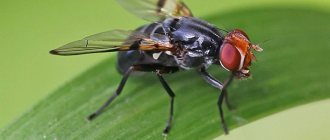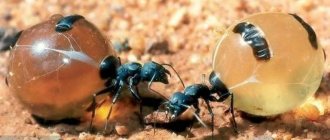The bumblebee (lat. Bombus) is an arthropod insect belonging to the family of bees and the genus Hymenoptera, one of its largest representatives. Bumblebees tolerate cold well, as during flight they develop a speed of up to 5 meters per second and produce energy, which is transformed into maintaining a constant body temperature of about 40 degrees; in extreme heat, they release a drop of liquid from their mouth and cool their head. This allows insects to collect pollen from plants early in the morning, when the air has not yet warmed up, which is a big advantage compared to bees.
An important fact is that regardless of their modest weight, bumblebees, just like ants, are capable of carrying heavy loads. A little earlier, scientists even assumed that from the point of view of physics they should not fly because of the proportions of their body and wings, but later this statement was refuted.
The bumblebee family is very social. They communicate using verbal and non-verbal communication, pheromones and wing movements. These methods convey information about nest safety, new food sources, and defense strategies.
Bumblebee appearance
Usually the insect has a black and yellow striped color, but depending on its habitat, individuals with completely black hair or with red stripes are observed. The color is also justified by the need for camouflage. Females can reach up to 3.5 cm in length, while males do not grow longer than 2.5 cm. Bumblebees have the fastest vision in the animal world - they have one pair of eyes in the front and photocells on the back of their heads, which help in determining the time of day. In addition to visual organs, they have strong jaws and a special proboscis for collecting nectar.
The photo shows a close-up of a bumblebee.
The appearance of female and male individuals differs in several ways. The head of female bumblebees has an elongated shape with a wide curve at the back. The upper lip is rectangular in shape and contains largely curved mandibles that close when compressed. In female organisms, the sixth abdominal sternite is always without characteristic ridges, and on the abdomen itself there is a multiple-acting sting without serrations. A basket is formed on the hind legs for collecting and storing pollen.
Male bumblebees have a triangular head, close to round, with a thin broken line running along the front and crown. Males on the second sternum do not have a median eminence, and instead of a sting, the genitals are dark brown. In addition, males have powerful jaws that allow them to chew through grass stems. They do not have a pollen basket, but instead have more pubescence.
Accommodation
Where do bumblebees live? They live on all continents, with the exception of Antarctica. In the Northern Hemisphere, they are more abundant in temperate latitudes, and their habitat extends beyond the Arctic Circle.
Bumblebees are considered the most cold-resistant representatives of bees. They cannot survive in the hot tropics. Body temperature can be up to 40 degrees, which is associated with rapid contraction of the chest muscles. This causes a loud buzzing sound. This is how the bumblebee warms up. When the movement stops, it cools down.
Bumblebee lifestyle and habitat
Due to their rapid adaptation to environmental conditions, bumblebees are found in every part of the world except deserted Australia and deserted Antarctica. Most often they are found in Europe and Africa. Depending on their habitat, their appearance and habits vary slightly.
Bumblebees live in families of about 100-200 individuals, less often - 500, consisting of queens, workers and males. In any community there is a clear division of responsibilities - queens are engaged in breeding offspring, workers build housing, bring food, feed larvae and collect nectar, and males only fertilize females. The first larvae emerging from the eggs are fed personally by the queen; subsequent generations are already under the care of the workers. If the queen dies, a working female takes her place. After fertilization, males leave the community forever. The family lives for one season, with the exception of the queens - they survive the winter.
An interesting fact is that the community has a unique trumpeter bumblebee, which can be heard in the mornings. It signals low air temperature and, with its loud sounds, awakens the entire hive so that its fellow tribesmen can quickly warm up the hive.
Bumblebees are beneficial insects that pollinate plants, including those that are inaccessible to bees. Therefore, they are not interested in anything other than flowers, and if disturbed, they will simply fly away to another plant.
Family life
Having chosen a place for the nest, the female builds the first wax cell into which she lays several eggs. She also collects nectar and pollen to feed the larvae, putting the compacted food in other cells.
When the larvae turn into adult workers, providing the family with food becomes their responsibility, and the queen almost never leaves the nest, breeding new generations of bumblebees. The total number of insects in one family is several hundred individuals. Male rearing begins in mid-summer. Interestingly, some working individuals can also lay unfertilized eggs for this purpose. Young males leave the nest and lead a solitary life while waiting for the young females to fly out.
Feeding bumblebee brood
At the end of summer, the bumblebee family hatches full-fledged females, who will become the founders of new families. After the emergence of new queens, the activity of the families decreases: they stop storing nectar and repairing cells, the number of insects gradually decreases, and with the cold, the life of the majority ends. Young queens dig holes in the ground and hibernate.
What do bumblebees eat?
Bumblebees feed on absolutely any nectar; some species especially love clover nectar. Insects also eat tree sap. The process of collecting food and eating it lasts from morning to evening. Relatives of bees prefer to process bright flowers, although this is not justified. In addition, they disperse seeds as they feed.
Larvae also need food, so upon returning to the nest, workers try to bring as much pollen and nectar as possible, which serve as food for future offspring. If necessary, the larvae are also fed with self-made honey.
Reproduction, development and life expectancy of bumblebees
Reproduction occurs by laying eggs and consists of 4 successive stages - egg, larva, pupa and adult.
The development cycle begins with the laying of eggs. Fertilization occurs in the fall, then the queens go to winter and in the spring they begin to actively arrange their future home, where they lay from 8 to 16 eggs.
After a few days, the eggs hatch into larvae. For 2 weeks they eat the food that the queen brings and grow actively.
Then the time comes for the 3rd stage - the larvae weave a cocoon and pupate. Finally, after 2.5 weeks, the young bumblebees gnaw through the cocoons and crawl out of them. Later, the empty cocoons are used as containers for storing honey and nectar. The first hatched worker bumblebees take over the duties of the queen in feeding the larvae, and the males leave the nests after 3-5 days in search of another community.
Life expectancy depends on what the individual does. Workers live no more than 2 weeks, males live for about a month - before mating, queens live the longest - born in the spring, they die no earlier than autumn, and if the female survives the winter, then she has a chance to live a whole year.
Features of bumblebee nests in the ground
After wintering, the fertilized queen begins to engage in construction. Most often, she places a bumblebee hive in the grass or between stones. Often, holes and burrows dug by small rodents are selected.
The first dwelling, which was built by the queen or the founder of the family, is an irregularly shaped oval cell. They are made from brown or red wax. The female lays 6 eggs at the bottom of each wax cell; a little honey and pollen are also placed in them to feed the emerging larvae. Only the first cells in bumblebee nests are made of wax; subsequently, the empty cocoons of pupae that have already hatched are used for such purposes. All created cells that do not contain larvae are filled with coarse honey and pollen. Some of the cells with honey and pollen remain untouched for a long time; they are intended for bad weather, when insects cannot fly out for food.
As the larvae grow, the cell walls move apart. To prevent the home from falling apart, the queen is constantly repairing the walls. As the colony expands, worker bees will help with repairs. When the time comes, the larvae pupate and inside the cocoon they turn into adults. After the completion of the formation of a new insect, the queen gnaws through the walls of the cocoon so that the young generation appears. The first bumblebees after laying eggs appear on days 25-27.
After wintering, the fertilized queen begins to engage in construction.
Bumblebee nests
The nest or “bombidarium” is built both on the ground and underground. It is worth noting that not all species build their own home on their own - there are both parasitic bumblebees that take over other people's nests, and cuckoo bumblebees that do not build nests at all.
Many species create nests underground, and can sometimes nest in the burrows of small rodents. This is due to the fact that the mouse smell attracts females. Also in the burrows there is the necessary material for insulating bombidariums, for example wool or straw. In exceptional cases, they can even drive out the inhabitants of a mouse hole and occupy it themselves, so as not to have to build a nest.
Several species of bumblebees set up their hives on the ground - in abandoned bird nests, on grass and in litter, under plants. There are also individuals that make their homes high above the ground - in tree hollows.
The shape of the home may vary depending on the location used by the insects. The hives are insulated with hay and moss and reinforced with our own wax. From this wax they build a kind of dome that protects against excess moisture, and it also serves as a disguise for the entrance to protect against attacks from uninvited guests.
When it is too hot outside, insects can ventilate the nest using their wings - their rotation speed is even greater than that of the hummingbird. This is an important process for the survival of the colony, because temperatures above 45 degrees are fatal to the offspring.
Building hives
The shape of the hives in and above the ground that bumblebees create depends on the cavity where they are located. Ground nests are most often made in the shape of a sphere. Dry moss, grass and wax are used for insulation and strengthening. The latter is a product of the vital activity of the insects themselves. Wax is produced by special glands on the abdomen. Thin strips of wax are formed on it, which the insect chews in its mouth until pliable. Already with a soft plastic material you can do whatever you want. The founder of the family secretes the wax first, then the working individuals take on this role. The result is a wax dome that protects the bumblebee nest from moisture penetration. The entrance is masked in a similar way so that enemies or cuckoo bumblebees do not get inside.
Interesting fact. The air temperature in the hive is maintained within 30-35 degrees. If the temperature increases, insects create artificial ventilation by flapping their wings at the entrance.
Features of bumblebees and differences from bees and wasps
Based on certain characteristics, you can easily distinguish bumblebees from their closest relatives - bees and wasps.
Bumblebees are noticeably larger than bees and wasps; in particular, this effect is achieved due to a thick layer of villi. Also, the coloring of wasps and bumblebees is brighter and more intense compared to bees.
The main difference between bumblebees and wasps is that they are vegetarians and feed exclusively on pollen and nectar. Wasps eat everything, not disdaining to eat other insects. In addition, they make preparations for the winter and leave with the whole family for the winter itself.
Wasp, bumblebee and bee.
Wasps and bumblebees can easily remove their stings from the victim and reuse them - they are smooth, without jagged edges. Moreover, wasps are very easy to anger, but bumblebees are not interested in this, and they sting very rarely. Bees leave their sting in the victim, as it is barbed and has a lock on the end, and die immediately, so they only use the sting when defending the hive.
All of the insects described above can produce honey, but only bee honey is widely consumed, while the rest are of little value to people or are too difficult to scale up production.
Description
Bumblebees belong to the class of arthropod winged insects and are a type of bee. The original name of the genus in Latin is “Bombus”. Creatures are widespread on Earth, living in all corners of the planet where there are suitable living conditions. Now zoologists know about 300 different varieties of insects, which belong to fifty subspecies.
The two most common types of bumblebees are Bombus terrestris and Bombus lapidarius. They live in most countries.
Back view of bumblebee
You can distinguish a bumblebee from other bees by its large size and rounded contours of its body. Thanks to the hairs on their body, they adapt well to cold climates and do not freeze. They are also considered warm-blooded insects. When moving quickly, their body begins to generate heat, and the internal temperature can reach forty degrees.
People have a stereotype that a bumblebee bite is very painful, and in general it is better to beware of insects.
Such fears arose due to the large size of the creature and powerful jaws. However, in fact, this type of bee is the most peaceful and harmless. Interesting fact : the sting of a bumblebee is smooth and does not have serrations, unlike a bee's.
If the latter retains it in the victim, then the bumblebee, having made a bite, can pull it back into the body and fly away. Bumblebees never attack first. They do not use their jaws as weapons, despite their power, and their only defense is their stinger. But the individual will use it if there is no other way out. Moreover, only females and insects that build a hive have it. Ordinary males do not have a sting and are almost completely defenseless. In nature, the bumblebee brings great benefits by pollinating a large number of flowers.
Types of bumblebees
There are approximately 300 different species of bumblebees in the world, let's move on to the description of the most famous:
Lugovoy (lat. Bombus pratorum)
A distinctive feature of the meadow bumblebee is that it leaves the wintering area earlier than anyone else. It is small in size, has a dark head and a bright yellow collar. It lives mainly in Europe and the Asian part of Russia.
Urban (lat. Bombus hypnorum)
The city bumblebee is no larger in size than the meadow bee. It differs from other subspecies in its red color in the chest area, as well as a black band and a white tip on the abdomen. Distributed throughout Eurasia.
Steppe (lat. Bombus fragrans)
Representatives of the steppe bumblebee are listed in the Red Book of Russia. They are one of the largest individuals - females can reach 3.5 cm in length. Steppe bumblebees live mainly in Eastern Europe and are pale yellow in color with a black stripe between the wings.
Underground (lat. Bombus subterraneus)
The unique features of underground bumblebees are their elongated proboscis and body, living in the warmer climate of Eurasia, and building nests underground. The color of the underground bumblebee is paler than that of other representatives, and the body size is average. These bumblebees were one of four species introduced from Britain to New Zealand in the early 20th century to pollinate clover. In the modern world, the species is on the verge of extinction.
Mokhovaya (lat. Bombus muscorum)
A medium-sized moss bumblebee with a bright golden color and a reddish back. Listed in the Red Book of many regions of Russia. It lives in almost all of Eurasia, except for the Arctic regions, preferring shrubby steppes and forest clearings.
Earthen (lat. Bombus terrestris)
Individuals of the ground bumblebee are medium-sized with an orange-black band on the back and a black chest color. Habitats: Europe, part of Asia and northwestern Africa. Since the end of the 20th century, ground bumblebees have been bred on an industrial scale, as they bring great benefits to agriculture - they pollinate various vegetables, fruits and berries.
Armenian (lat. Bombus armeniacus)
The Armenian bumblebee is one of the rarest species and is also listed in the Red Book of Russia. It has a rather long body - up to 3.2 cm, brown wings, very elongated cheeks and light yellow hair. Habitat: steppe zones of Eastern Europe and Asia.
Forest (lat. Bombus sylvarum)
The forest bumblebee is found in the forests and steppes of Eurasia, as it is thermophilic. One of the smallest species - body length does not exceed 1.5 cm. The color of forest bumblebees is faded, non-contrasting - a black body with yellow-orange hairs.
Garden (lat. Bombus hortorum)
Garden bumblebees feed mainly on legume nectar and have a long proboscis. These bumblebees were one of 4 species introduced from Britain to New Zealand in the early 20th century to pollinate clover. Insects are medium-sized with a yellow color and a wide black stripe between the wings. The head is black, slightly elongated.
Common (lat. Bombus latreille)
The common bumblebee has black hair with a couple of yellow stripes and a small white spot at the tip. Often found in vegetable gardens in Russia. Widely distributed in western Europe. Listed in the Red Book. It is a fairly small individual and rarely grows longer than 1.5 cm.
Do bumblebees make honey?
Like other representatives of the bee family, bumblebees also produce honey, only the product of their activity has slightly different properties. It has a thinner consistency, similar to sugar syrup, and is much lighter than bee honey. It also has a lower specific gravity and is not as sugary as that of bees, but such honey is 2 times healthier than bee honey.
Bumblebees create honeycombs in the unusual shape of pitchers. Their number is smaller than that of bees, but they are more spacious. Toward the bottom, the honeycomb expands slightly in diameter, and when sealed, it becomes bag-like.
Bumblebees live no more than a year, so breeding them for the sake of a small amount of honey is pointless and unprofitable.
Where and how do bumblebees winter?
The bumblebee community exists from early spring to early winter. At the end of autumn, the males fertilize the main females for the last time, after which the queens hibernate and all other residents of the hive die. The queen survives frost underground at a depth of approximately 15-20 cm, usually in a place not far from the old nest. When spring comes, the main females awaken from sleep, create a new home, where they raise the first generation of new offspring and then die. They are replaced by newly hatched females.
Natural enemies of bumblebees
Bumblebees have many natural enemies, despite their neutrality and usefulness. Ants are one of the main serious enemies of the bee family. They steal their eggs and honey and destroy their hives, so bumblebees often build their homes away from the ground. Communities try to defend their homes, but the defense is often ineffective as most fly away during the day to pollinate flowers and collect nectar.
Another unpleasant enemies are birds, animals and other insects. For example, predators like foxes, hedgehogs and wolves destroy nests and eat offspring. Conopid flies lay their eggs in the bodies of bumblebees while they fly. They grow by feeding on the innards of their prey.
Bumblebees even conflict with representatives of a related species - wasps, since the latter often steal honey, eat larvae and lay their own on enemies.
Interesting Facts
These insects can regulate their body temperature, warming it up to 40°C, so they tolerate cold well and can start working from dawn. They are one of the most cold-resistant insects.
In hot weather, bumblebees fly out of the nest and begin to actively fan it with their wings, ventilating their home.
An insect flaps its wings up to 400 times per second! Flies at speeds up to 20 km/h. According to all the rules of aerodynamics, a bumblebee should not fly; its flight violates the laws of physics. This is one of the mysteries of nature that scientists have not yet solved.
This is a peace-loving insect that never attacks without reason, unless you show aggression towards it. If a bee dies after being stung, then its furry relative does not; it can sting many times. A bumblebee sting is painful and can be very dangerous for allergy sufferers.
It is known that bumblebees do not like strong odors - perfumes and deodorants, air fresheners, alcohol, sweat. They may attack precisely because they are disturbed by an unpleasant odor. For some reason they also react aggressively to watches, jewelry and the color blue.
This is a very useful pollinating insect, without which many plants could not reproduce.
Their honey is not used by humans, since it is liquid and begins to ferment already at a temperature of +3...+4°C.
Bumblebees have many natural enemies - foxes, badgers, voles and other rodents, ants, moths, wax moths, some types of wasps and flies, the European bee-eater, nematode worms, gamas mites, red cockroaches, and parasitic hyphomycete fungi.
The importance of bumblebees in nature and their impact on the environment
Bumblebees are perfectly adapted to pollinating many agricultural plants, and they do it several times faster than bees. Bumblebees process any plants, without dividing them into convenient and not so convenient. Thanks to their structure and external features, bumblebees fly even in bad weather conditions, starting their day at dawn and ending at dusk. Plants pollinated by bumblebees grow faster. In addition, bumblebees can also work with frost-resistant flowers, since they themselves are not afraid of the cold. During an outing lasting 100 minutes, the insect is able to process 2634 flowers.
The family of bees and bumblebees has a huge impact on the environment. If the bumblebees disappear, there will be no one to process the plants and they will die. Without flora, animals will die out, the planet will become empty, and humanity will also be on the verge of extinction.
Bumblebee protection
There are several hundred species of bumblebees in the world, many of which are on the verge of extinction and are listed in the Red Book. There are several good reasons for reducing their numbers: air pollution, insufficient food, the use of pesticides, hostility with serious rivals. Some species of the family are attached to certain types of plants, and with their disappearance they themselves are endangered.
Modern man makes no effort to protect these helpers. The indifference is due to the fact that simultaneously with the gradual extinction of several species of bumblebees, there is an increase in the population of others, and in general the community remains unchanged in its numbers.
Aerodynamic characteristics
Bumblebee in flight
For a long time it was believed that bumblebees could fly, contrary to the laws of physics. Indeed, a massive body carried on one pair of small wings is quite an unusual sight. However, physicist Jane Wang from a US university was able to prove that there is nothing surprising in the flight of a bumblebee.
The scientist spent several hours simulating the passage of dense wind currents through the moving wings of an insect and found that this process fully complies with the laws of physics.
Why do some gardeners breed bumblebees?
Breeding bumblebees is a godsend for gardeners; it is used to improve the yield of agricultural crops, as well as to increase their number. Honey is just a pleasant bonus from bumblebee farming, since little of it is produced, and bumblebees can suddenly leave their home.
Bumblebees bring many benefits, so many summer residents decide to breed them at home. Usually about 50 individuals from one family are placed in a pre-prepared nest. This will allow them to get along well with each other, distribute responsibilities correctly and begin pollinating plants.
If colonization is successful, the queen quickly begins to produce new offspring, and workers begin to set up the farm. Before the onset of cold weather, the owner must fatten the queen so that she can survive the winter.
